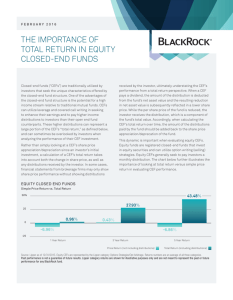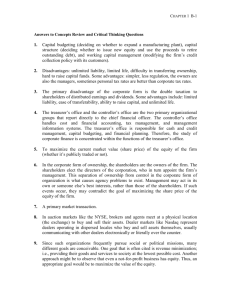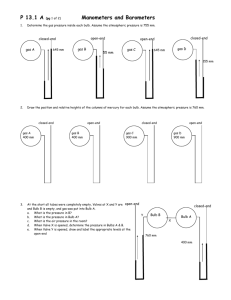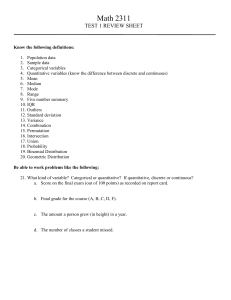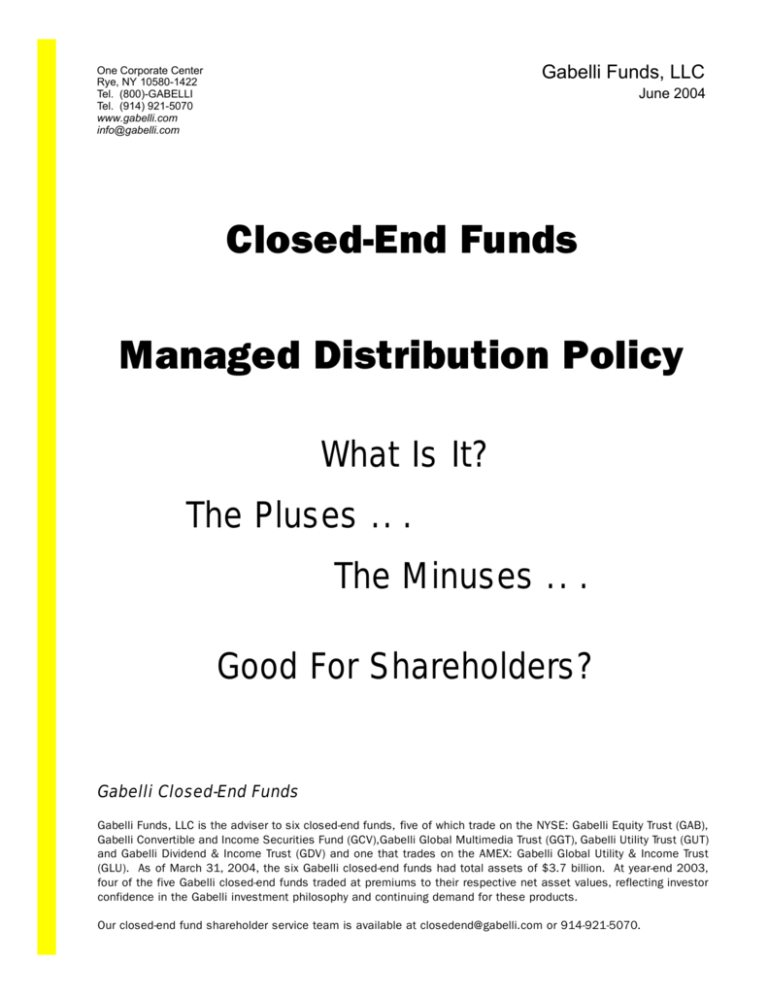
Gabelli Funds, LLC
One Corporate Center
Rye, NY 10580-1422
Tel. (800)-GABELLI
Tel. (914) 921-5070
www.gabelli.com
info@gabelli.com
June 2004
Closed-End Funds
Managed Distribution Policy
What Is It?
The Pluses .. .
The Minuses .. .
Good For Shareholders?
Gabelli Closed-End Funds
Gabelli Funds, LLC is the adviser to six closed-end funds, five of which trade on the NYSE: Gabelli Equity Trust (GAB),
Gabelli Convertible and Income Securities Fund (GCV),Gabelli Global Multimedia Trust (GGT), Gabelli Utility Trust (GUT)
and Gabelli Dividend & Income Trust (GDV) and one that trades on the AMEX: Gabelli Global Utility & Income Trust
(GLU). As of March 31, 2004, the six Gabelli closed-end funds had total assets of $3.7 billion. At year-end 2003,
four of the five Gabelli closed-end funds traded at premiums to their respective net asset values, reflecting investor
confidence in the Gabelli investment philosophy and continuing demand for these products.
Our closed-end fund shareholder service team is available at closedend@gabelli.com or 914-921-5070.
Gabelli Funds, LLC
At Gabelli Funds, LLC, we believe the best fund shareholder is an informed fund shareholder. Accordingly, we periodically share with
you our thoughts on topics relating to our investment products. This report provides a background on closed-end funds, explains
some of their features and details the managed distribution policy initiative we have taken to add value for our closed-end fund
shareholders.
In April of 2002, we prepared a report on the history of closed-end funds. We continued in August of 2002, with a report on the
rationale and benefits of rights offerings. The purpose of this report on managed distribution policies is to describe the pros and
cons of these distribution policies and their effect on closed-end funds. We hope this report will provide a better understanding of
closed-end funds and, in the process, enhance your ability to make sound investment choices.
What is a Closed-End Fund?
Investment companies are available in two structures, either as “open-end” mutual funds or “closed-end” funds. An open-end
mutual fund, either load or no-load, bases its offering and redemption share price on the fund’s net asset value per share (NAV) at
the end of each trading day. A closed-end fund is a publicly traded investment company that raises its initial investment capital
through the issuance of a fixed number of shares to investors in a public offering. To facilitate trading, shares of closed-end funds
are listed on an exchange, such as the New York Stock Exchange (NYSE) or the American Stock Exchange (AMEX) and trade just
like the stocks of other publicly traded companies.
What is Net Asset Value Per Share (NAV) vs. the Market Price?
The net asset value per share or NAV of an investment company, either open-end or closed-end, is the total market value of all the
securities and other assets held by a fund minus the total liabilities, divided by the total number of common shares outstanding. The
NAV of an investment company will fluctuate with the changes in the market prices of the securities held by a fund. However, the
market price of a closed-end fund is determined in the open market by buyers and sellers. This public market price is the price at
which investors may purchase or sell shares of a closed-end fund. The market price of a closed-end fund fluctuates throughout the
day and may differ from its underlying NAV, based on the supply and demand for a fund’s shares on the open market. Shares of a
closed-end fund may trade at a premium (higher than) to NAV or a discount (lower than) to NAV. The difference between the market
price and the NAV is expressed as a percentage. For example, if the NAV of a closed-end fund is $20 and its market price is $24,
the fund is trading at a premium of 20%. If the NAV is $20 and its market price is $16, the fund is trading at a discount of 20%.
Market Value = Shareholder Value
Theoretically, a closed-end fund's shares should trade at its NAV, just as with an open-end fund, since the NAV represents a fund’s
liquidation value. In practice, closed-end funds usually trade at market prices above or below their underlying per share NAV. The
reasons for this may include: the performance of the fund, market sentiment, brand name, investment style, supply or new issuance
of other funds, a rights offering, a secondary offering , and the existence of a distribution policy.
What is a Managed Distribution Policy?
An investment company makes distributions of investment income (dividends and interest received and net realized short-term
capital gains) and net realized long-term capital gains in order to qualify for favorable tax treatment under the Internal Revenue
Service Code. To avoid double taxation (both at the corporate (or fund) level and for shareholders), an investment company will
generally distribute all of its investment income and net realized long-term capital gains each year. As a regulated investment
company, tax benefits associated with the underlying investments can be passed through to shareholders.
A managed distribution policy is an investment company’s commitment to common shareholders to provide a predictable, but not
assured, level of cash flow. This distribution policy typically takes the form of a regular fixed cash payment or a payment based on
a percentage of a fund’s assets, generally on a monthly or quarterly basis.
Investors may desire a fund that offers both a current income stream and the higher long-term return potential of common stocks.
According to Ibbotson Associates, a leading provider of data on long-term investment returns, the average annualized return for
stocks from 1926 through 2003 was 10.3%. This 10.3% return consists of a 4.3% average annualized dividend return with the
balance coming from a capital appreciation component. Today, the dividend yield on the S&P 500 is only 1.7%. Even with the recent
upward movement, short-term interest rates remain near four-decade lows.
So, how does an investor access the potentially higher long-term return available from stocks and receive an above market level of
current income? A closed-end equity fund with a managed distribution policy may provide investors with a vehicle that offers
participation in the potentially higher long-term total returns available from the stock market as well as an above market level of
current income. A closed-end fund with a managed distribution policy may offer a consistent, periodic distribution, generally
comprised of dividend income, interest income, net realized capital gains (both long and short term),and possibly a return of capital.
Investors may further compound their total return by reinvesting distributions in additional shares of the closed-end fund.
Gabelli Funds, LLC
An additional benefit available to individuals investing in stocks or equity funds comes from the Jobs and Growth Tax Relief
Reconciliation Act of 2003 which lowered the maximum Federal income tax rate on qualified dividend income from 38.6% to 15%
and long-term capital gains from 20% to 15%. This makes the after tax return on dividend paying stocks more attractive relative to
other investments than was the case prior to 2003. Closed-end funds may pass through qualified dividends as a component of
their distributions to shareholders, thus allowing shareholders to benefit from the 15% tax rate.
Advantages of a Managed Distribution Policy
There are advantages of a managed distribution policy beyond offering an investor the opportunity to participate in equity returns
while enjoying a level of cash flow. Managed distribution policies generally serve to reduce the existing discount between a closedend fund’s market price and its NAV per share. Moreover, a number of academic studies and industry reports suggest that funds
with a managed distribution policy tend to trade at smaller discounts or even premiums to NAV. A managed distribution policy
may also support a fund’s market price during periods in which the stock market is retreating. Further, a managed distribution
policy provides a measurable performance target for the investment adviser to generate returns greater than the distribution
amount.
Disadvantages of a Managed Distribution Policy
There are drawbacks to a managed distribution policy as well. A regular distribution provides shareholders with dependable cash
inflows but conversely results in consistent cash outflows from a fund. These cash outflows from a fund are “lost assets” that
would otherwise remain available for investment by a fund’s adviser. Additionally, a fund may need to hold an above average cash
position in preparation for regular distributions. Each of these factors runs counter to a structural advantage of a closed-end fund,
which is to retain all assets and allow a fund to remain fully invested.
A managed distribution policy may create confusion regarding the true “yield” of a closed-end fund. All too often, investors, financial
publications, newspapers and websites simply use a fund’s distribution payment and current market price to calculate the “current
yield”. Investors should be wary of these incorrect “yield” calculations, particularly when applied to closed-end equity funds. A
“current yield” calculation for a closed-end equity fund with a managed distribution policy is irrelevant because the fund's current
market price is not a factor in determining a fund’s distribution. Generally, a closed-end fund’s distribution policy is in the form of
a regular fixed payment or a payment based on a percentage of a fund’s net assets. Investors should be aware that distribution
payments may vary during the year, sometimes including a fourth quarter equalizing distribution. Lastly, a fund’s distribution may
contain a return of capital, which should not be counted as “yield”.
Return of Capital
If a fund's distribution is not fully covered by investment income and net realized capital gains, the excess portion will be a return
of capital. Essentially, a return of capital gives shareholders back their own principal and results in a reduction of capital invested
in the fund. In addition, a return of capital makes record keeping more complicated since taxable investors must reduce their cost
basis by that amount. A fund's expense ratio may also increase if it distributes capital thereby lowering the fund’s total assets
available for the expense ratio calculation. However, despite the challenges of the extra record keeping, a distribution that is
occasionally supplemented with a return of capital serves as a smoothing mechanism resulting in a more stable and consistent
cash flow available to shareholders.
Tax Dynamics of a Managed Distribution Policy
In 1997, our Gabelli closed-end funds requested and received an exemptive order from the Securities and Exchange Commission
from Rule 19b-1 of the Investment Company Act of 1940 that prohibits a mutual fund from distributing realized net long-term capital
gains more than once a year. This exemptive order allows Gabelli closed-end funds with a stated distribution policy to distribute
realized net long-term capital gains more frequently than once a year. Hence, Gabelli closed-end funds are able to allocate net longterm capital gains realized throughout the year equally to each distribution during that year, providing a more consistent as well as
tax-advantaged level of cash flow to shareholders.
If a fund does not generate a total return from dividends and interest received and net realized capital gains in an amount equal to
or in excess of its stated distribution in a given year, and the fund's Board of Directors determines that shareholders favor a stable,
consistent distribution policy, then the amount distributed in excess of a fund's investment income and net realized capital gains
would be deemed a return of capital. Since this would be considered a return of a portion of a shareholder's original investment,
it is not taxable and is treated as a reduction in the shareholder’s cost basis. For a closed-end fund with a distribution policy, a
return of capital becomes progressively less likely with the passage of time because in later years it is more likely that long-term
capital gains can be realized and therefore become available for distribution. The Gabelli Equity Trust underscores this point since
its long-term capital gains have accounted for a significant percentage of recent distributions.
Gabelli Funds, LLC
The Gabelli Equity Trust Distribution Policy – A Look Back
The Gabelli Equity Trust was launched in August of 1986. Raising $400 million, it was one of the largest equity closed-end fund
offerings at that time. The Equity Trust’s primary objective is to provide shareholders with long-term growth of capital, with income
as a secondary objective. The Equity Trust initiated a distribution policy in 1988 following the stock market collapse in October
1987, when many stocks tumbled over 20% in one month. Although the Equity Trust’s NAV held up relatively well during this market
crash, the Equity Trust’s common stock traded at a significant discount to its NAV. Shareholders and management viewed the
discount as unwarranted and unacceptable. In response, our first shareholder initiative was the Board of Directors’ authorization
to repurchase shares of the fund’s common stock immediately after the close of trading on Black Monday, October 19, 1987.
In the summer of 1988, as the prospects for stocks improved, we established an annual distribution policy of 10% of the Equity
Trust’s average net asset value, consistent with the Equity Trust’s objective of generating a 10% real rate of return from the
investment portfolio. This distribution policy is intended to provide shareholders with a predictable, but not assured, level of cash
flow. Of course, if the portfolio's investment income and net realized long-term capital gains do not equal or exceed 10% of the
Equity Trust’s average net asset value in any given year, then the excess portion of the distribution would be deemed a non-taxable
return of shareholder capital. Our distribution policy was well received by shareholders and, along with other factors, contributed
to a lower discount to NAV in the twelve months following its implementation.
The Gabelli Equity Trust has a history of successful investing, providing shareholders with an average annual return of 11.7% from
its inception in 1986 through year-end 2003. The returns of the Equity Trust assume the reinvestment of investment income
(dividends, interest and net realized short-term capital gains), net realized long-term capital gains, the intrinsic value of any rights
offerings and spin-offs, and taxes paid on undistributed long-term capital gains. The Equity Trust has distributed $1.6 billion to its
shareholders since 1986. The majority of the Equity Trust’s distributions, 64%, came from net realized long-term capital gains
generated from sales of appreciated portfolio securities. An additional 17% of the total distributions are attributable to net
investment income and net realized short-term capital gains. The remaining 19% of distributions represents a tax-free return of
capital, including the spin-off of two closed-end funds, the Gabelli Global Multimedia Trust in 1994 and the Gabelli Utility Trust in
1999. Since 1997, long-term capital gains comprised over 85% of each year’s distributions. The Equity Trust continues its policy
of distributing 10% of its average net asset value to shareholders and this policy is now in its seventeenth consecutive year.
Pros and Cons of Closed-End Fund Managed Distribution Policies
Pros
● Consistent income stream for shareholders
● Initiative designed to reduce discount to NAV
● Creates support for a fund’s common stock in declining markets
● Presents the adviser with a measurable performance target
● Provides adviser incentive to earn distribution to avoid a return of capital
● Increases share liquidity
Cons
● Return of capital complicates record keeping
● May create confusion regarding true "yield"
● Increased cash positions contrary to purpose of fully invested closed-end structure
● Uses capital for distribution versus investment
● Increases expense ratio if distribution exceeds investment performance
Closing Thoughts
A closed-end fund's investment adviser has a primary responsibility to enhance shareholder wealth by consistently growing a fund’s
NAV. In an ideal world, closed-end funds should trade at or above their NAV. Unfortunately, the vicissitudes of the stock market
may result in a closed-end fund trading at a significant discount to its NAV. Consequently, we believe a fund’s adviser and its Board
of Directors should institute policies designed to narrow, or ideally eliminate, any discount to NAV. Throughout our history, we have
taken both of these responsibilities quite seriously. We are justifiably proud of our investment record and the fact that we have
initiated policies such as share repurchase programs and managed distribution policies designed to prod our Funds’ share prices
to more closely track our Funds’ NAV.
As always, we invite you to share your thoughts with us on any aspect of our stewardship of the assets you have entrusted to us.
For more information, visit our website at:
www.gabelli.com or call: 8 0 0 - G A B E L L I
800-422-3554 ● 914-921-5100 ● Fax: 914-921-5118 ● info@gabelli.com
Gabelli Funds, LLC, One Corporate Center,Rye, NY 10580-1422
Copyright© 2004 Gabelli Asset Management Inc.- All rights reserved.
The average annual returns for the Gabelli Equity Trust on an NAV per share basis through 3/31/04 for the one, five and ten-year periods
and the period since inception on 8/21/86 are 56.54%; 6.25%; 10.53%; 11.66%, respectively. The past performance noted does not
guarantee future results. Average annual returns reflect changes in NAV, reinvestment of distributions at NAV on the ex-dividend date,
adjustments for rights offerings, spin-offs and taxes paid on undistributed long-term capital gains, and are net of expenses. Investment
results and the principal value of an investment will fluctuate. When shares are redeemed,they may be worth more or less than their original
cost. Current performance may be lower or higher than the data presented. Visit www.gabelli.com for more recent month end performance
information. Investors should consider the investment objectives, risks and charges and expenses of the Fund before investing.


